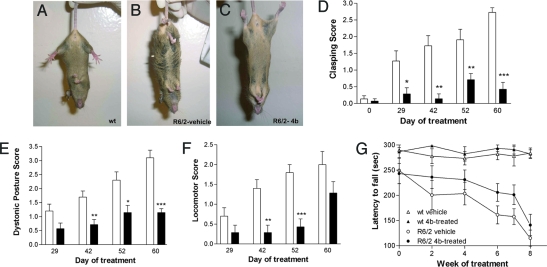Fig. 1.
Behavioral phenotypes of vehicle- and HDACi 4b-treated mice. Hindlimb clasping phenotype of WT mice (A) and R6/2300Q transgenic mice treated with vehicle (B) or HDACi 4b (C). The differences between HDACi 4b-treated (filled bars) and vehicle-treated (open bars) R6/2300Q transgenic mice are shown for the clasping phenotype (D), dystonic posture (E), and locomotor activity (F) over the time of drug treatment. Two-way ANOVAs were used to determine the effect of HDACi 4b treatment and treatment duration on each of these measurements. *, P < 0.05; **, P < 0.001; ***, P < 0.0001. (G) Rotarod performance of HDACi 4b-treated and vehicle-treated WT and R6/2300Q transgenic mice throughout the treatment duration. Time-point 0 reflects baseline performance. Two-way ANOVA revealed significant differences between WT and R6/2300Q transgenic mice with time (P < 0.0001), as well as a significant effect of drug treatment in R6/2300Q transgenic mice (P < 0.05). Bars represent mean score ± SEM (n = 7 to 8 per group).

